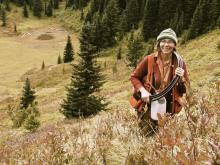By Joyce LeCompte-Mastenbrook
Joyce LeCompte-Mastenbrook’s dissertation research is examining the connections between traditional foods revitalization in Coast Salish territory and the scientific and political aspects of management of public lands in the Cascades of Washington and British Columbia. As foodways are integral to cultural identity, food sovereignty is likewise central to the social, cultural, physical, and spiritual well being of indigenous people and communities. Chronic and life-threatening illnesses including type-2 diabetes, heart disease, and obesity are on the rise in Native communities in both the US and Canada, typically at much higher rates than either country’s general populations. Because traditional foods nourish both body and spirit, a return to a diet resembling that of pre-contact times is viewed by traditional foods practitioners and advocates as an effective way to address these pressing health issues.
While numerous revitalization programs in First Nations and Native American communities have emerged over the past several years, substantial barriers to accessing traditional foods exist. These include land conversion, incompatible land management policies and practices, and concerns over environmental pollution and toxicity. Invasive species and climate change also threaten the long-term sustainability of culturally important plants, animals, and places.
To better understand the connections between traditional foods and public lands management, LeCompte-Mastenbrook is focusing on the changing connections and interactions with the land in several places and communities throughout the Cascades. This work traces both the creation and maintenance of a colonial landscape and new collaborative relationships between Coast Salish people, land managers, forest and wildlife ecologists, archaeologists, animals, plants, and the landscape itself.
Her research began four years ago when she started looking at the dynamics of harvest and management of mountain huckleberry, or “sweda?x?” in Lushootseed. This highly prized berry was historically one of the primary reasons for Coast Salish peoples’ forays to the Cascade Mountains in late summer. In the U.S., the majority of huckleberry habitat occurs on public lands managed by the U.S. Forest Service. It is commonly acknowledged that management practices over the course of the past century—particularly fire suppression—have resulted in declining huckleberry productivity. Many formerly productive huckleberry meadows are now degraded or have disappeared entirely.
For the past two years, LeCompte-Mastenbrook has been working with the Muckleshoot Indian Tribe on an ethnoecological history of huckleberry harvesting in Muckleshoot traditional territory. This work traces the material and symbolic significance of these high elevation landscapes to Coast Salish people, and the rapid transformation of both people and the land during the period of colonization. To better understand new “co-management” relationships between tribes and land management agencies, she is also serving as an outside observer on the Tulalip–Mt. Baker–Snoqualmie National Forest’s “Cedar-Huckleberry Technical Committee.”
This year, she plans to expand her research to Mount Rainier National Park, where she will examine a developing change in policy, which is intended to make it easier for federally recognized tribes to harvest plant resources inside the boundaries of National Parks. This work will document a project with tribal plant harvesters, park staff, and plant ecologists to develop a protocol for assessing the impacts of tribal harvesting on plant resources within the park.
Readers with an interest in the traditional foods revitalization movement will be interested to know about the upcoming “Traditional Foods Summit” on March 29-30, which is being held in conjunction with the Society for Applied Anthropology Meetings in Seattle. More information can be found here:http://www.sfaa.net/sfaa2011/2011foodsummit.html.
Photo notes:
1: Joyce LeCompte-Mastenbrook, huckleberry gathering, summer 2010.
2: Warren King-George (Muckleshoot oral historian), Elizabeth Swanaset (Nooksack), Tracy Fuentes (USGS botanist), and Professor Eugene Hunn (UW emeritus) on a plant-collecting excursion at a traditional huckleberry gathering site in Muckleshoot traditional territory, summer 2010.
